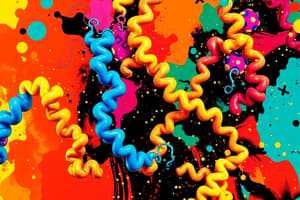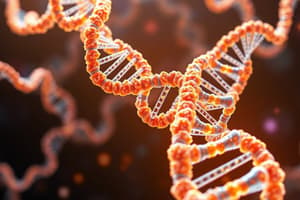Podcast
Questions and Answers
What dictates the shape and structure of proteins?
What dictates the shape and structure of proteins?
- The size of the protein
- The location where the protein is found
- The amino acid sequence of the polypeptide chain (correct)
- The color of the protein
Which of the following are examples of secondary structures of proteins?
Which of the following are examples of secondary structures of proteins?
- α-helices and β-sheets (correct)
- Ribosomes and nucleic acids
- Lipids and sugar molecules
- Tertiary and quaternary structures
Why is understanding protein structure crucial?
Why is understanding protein structure crucial?
- To uncover the roles proteins play in life (correct)
- To identify the size of proteins
- To discover new classes of biomolecules
- To determine the color of proteins
Proteins often function in concert with other molecules as part of larger assemblies. What are ribosomes responsible for?
Proteins often function in concert with other molecules as part of larger assemblies. What are ribosomes responsible for?
What new class of biomolecules has been discovered, demonstrating the flexibility of traditional biomolecule boundaries?
What new class of biomolecules has been discovered, demonstrating the flexibility of traditional biomolecule boundaries?
How do proteins facilitate the transport of molecules across cell membranes?
How do proteins facilitate the transport of molecules across cell membranes?
What are the core components of life that serve as workhorse molecules driving cellular processes?
What are the core components of life that serve as workhorse molecules driving cellular processes?
How are amino acids linked together in a protein?
How are amino acids linked together in a protein?
According to the HP protein-folding model, what subunits were proposed as the early building blocks of proteins?
According to the HP protein-folding model, what subunits were proposed as the early building blocks of proteins?
Which type of protein structures can range from elongated fibers to compact globules?
Which type of protein structures can range from elongated fibers to compact globules?
In biological processes, what is the primary role of proteins functioning as enzymes?
In biological processes, what is the primary role of proteins functioning as enzymes?
Flashcards are hidden until you start studying
Study Notes
Proteins: The Lifeblood of Biological Function
Proteins are core components of life, serving as the workhorse molecules that drive cellular processes and maintain the structure and function of living organisms. Each protein is a complex biopolymer, consisting of one or more long chains of amino acids, linked together by peptide bonds. The specific sequence of amino acids in a protein determines its unique shape, function, and properties.
Protein Origins and Evolution
Proteins have long been regarded as secondary players in the origins of life, with RNA molecules being the early self-replicating biomolecules. However, a new computational model and experimental evidence challenge this view. The HP protein-folding model suggests that proteins, with their simpler hydrophobic-polar (HP) subunits, could have originated and folded into functional structures earlier than RNA. According to this hypothesis, proteins served as the first self-replicating biomolecules, followed by the evolution of RNA molecules into the RNA world hypothesis.
Protein Structures and Functions
Protein structures are diverse, with shapes ranging from elongated fibers to compact globules. They can serve as enzymes, catalyzing chemical reactions, or as structural elements within cells, providing the framework for larger structures. Proteins also function as transporters, hormones, and antibodies, participating in a wide range of biological processes.
The Shape and Structure of Proteins
Protein shape and structure are dictated by the amino acid sequence of the polypeptide chain. Proteins can fold into complex, three-dimensional structures characterized by secondary structures such as α-helices and β-sheets, as well as tertiary and quaternary structures. The unique shape of a protein is essential for its function, so understanding protein structure is crucial to uncovering their roles in life.
Protein Assembly and Interactions
Proteins often function in concert with other molecules or as part of larger assemblies. For instance, proteins can form multimeric complexes or be incorporated into protein complexes such as ribosomes, which are responsible for protein synthesis. Many proteins also interact with other biomolecules, such as nucleic acids and lipids, to mediate cellular processes or to facilitate the transport of molecules across cell membranes.
The Future of Proteins in Biology
Recent discoveries have expanded our understanding of proteins, revealing new classes of biomolecules such as glycoRNAs, which are RNA molecules with sugar molecules attached. These findings demonstrate that the boundaries between traditional classes of biomolecules are not as rigid as once thought, and suggest that there may be many more surprising discoveries waiting to be made.
Studying That Suits You
Use AI to generate personalized quizzes and flashcards to suit your learning preferences.




